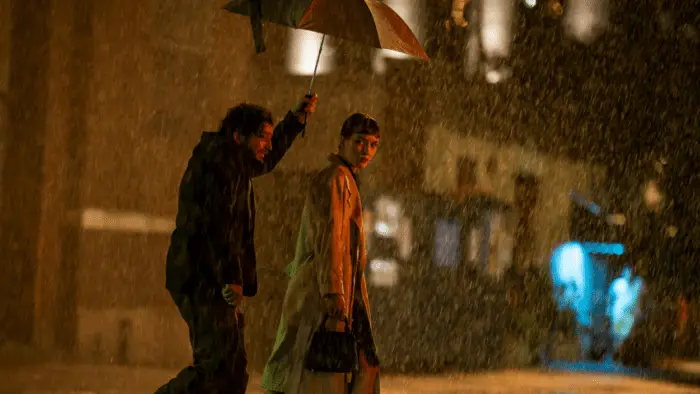A curiosity—what’s up with John Magaro playing writers and novelists lately? In Celine Song’s Past Lives, Magaro portrays Arthur, an author caught in the crossroads—albeit with significant grace—between his Korean wife Nora (Greta Lee) and Hae-sung (Teo Yoo), the Korean man she was once infatuated with from childhood to early adulthood. In Tolga Karaçelik’s The Shallow Tale of a Writer Who Decided to Write about a Serial Killer (a sizably greater, Iñarritu-sized mouthful), Magaro plays Keane, an author caught in the crossroads—with much less grace and in a very different way—between his detached wife Suzie (Severance‘s Britt Lower) and former serial killer Kollmick (Steve Buscemi), who becomes the subject of his next novel.
Funnily enough, however, both film are deeply romantic in their own distinctly absorbed ways, with Song phrasing it through the lens of immigration and identity, and Karaçelik phrasing it through the unexpected ways that the morbid can often be intertwined with attachment. It’s hard to guess that The Shallow Tale is designed in such a tonally balanced way, as it’s ostensibly stripped of warmth and any open expressions of love. After all, one of the first things we see is an almost dissociative Suzie telling a driving Keane that a green light’s come on when it’s clearly still red, and a truck almost plows through their car. Nearly the very next night, Suzie, cutting up a mountain of onions with ghastly stained mascara, tells Keane that she wants a divorce for his total lack of initiative towards their marriage while carrying a knife in her hand, wielding it around with a menace that obfuscates which way the edge will turn next.

In trying to sell what appears to be an unmarketable novel idea about the last homo sapiens and a tribe of Neanderthals, Keane crosses paths with Kollmick, who’s a big fan, and wants to be a “counselor” for Keane’s next novel. He seems to claim that he’s a “retired serial killer,” and sells it with just how much he seems to know about forensic procedure and how regularly he manages to stalk Keane—and he wants Keane to strive towards a more marketable idea for writing about the life of a serial killer instead. When Keane drunkenly invites Kollmick into his and Suzie’s home one night, a misunderstanding about Kollmick’s occupation leads to Kollmick inadvertently becoming Keane and Suzie’s marriage counselor—something that they end up taking with as much grace as they can. From even there, a series of misunderstandings about Keane and Kollmick’s working relationship, mainly from the former’s attempts to simulate the serial-killer experience for Keane’s literary purposes, leads Suzie to believe that Keane is out to kill her, laid out with morbidly hilarious believability through the ways Keane’s true-crime research intersects with his attempts to reconnect with his wife.
The primary triad of performances in this film are impressive enough to be mentioned on an individual basis. From the moment The Shallow Tale opens, Buscemi makes his presence known through delivering a deeply unsettling monologue that reoccurs later in the film about the helplessness that the victims of serial killers face right before their deaths. But the profoundly creepy impression one gets of Kollmick is also often cleverly subverted by the fact that his morbidity also leaks into his cover as a marriage counselor for Keane and Suzie, made evident by how he brings in his taxidermied cat, Ada, into his “sessions” and brings up death as a metaphorical subject to examine marriage through.

Magaro, in the meantime, is certainly the most innocent of the bunch, hilariously playing up Keane’s desperation to not only join hands with someone who could probably murder him at any point, but also try and persuade that same person to help mend a disastrously failing marriage that he’s shocked to find out hasn’t been working. Keane and Kollmick regularly refer to themselves as Don Quixote and Sancho—a fitting analogue to a tale of loyalty to each other in the face of gradually dissolving sanity. Yet it’s Lower who delivers the strongest impression of the film and eventually grows to become its highlight. From the moment she monotonously and sarcastically “encourages” Keane’s novel ideas to the instances where that cold, detached veneer seems to break away slightly, Lower manages to take Suzie’s character from fear-inducing to fearful and all the way back over again. It’s the kind of performance that offers up a lot of fun to witness, just to see how she would react and adapt to the morbidly comedic circumstances of Keane and Kollmick’s partnership.
That kind of morbid comedy is what makes up much of The Shallow Tale‘s thrills from start to finish, with each scene containing some kind of surprise or subversion packed with significant dramatic irony, keeping its pacing consistently engaging and intriguing. The formal craft of the film isn’t anything particularly exceptional, though; the film navigates only through a handful of locations at a time, and with the sole exception of the fact that the first image of the film is a black-and-white, 4:3-aspect-ratio scene depicting Keane’s literary Neanderthals, the film doesn’t aesthetically deviate very far from a more grounded aesthetic based in a pretty strict sense of reality.
Ultimately, however, the charm of the film lies in the fact that its three leads are able to sell a tale of unorthodox self-discovery so well—the ways we grow to understand what we’re capable of in the face of forces we never would expect would help get us to those points. Whether that means bonding with serial killers who want to simulate the experience for the best kind of interactive research, or having that same serial killer turn into a morbidity-obsessed marriage counselor to mend a long-broken marital bond, the revelations that come awake by the end of the film are interesting enough to be entertaining, even if some aspects of them may leave more deep-dive-inclined viewers searching for just a little bit more insight.



